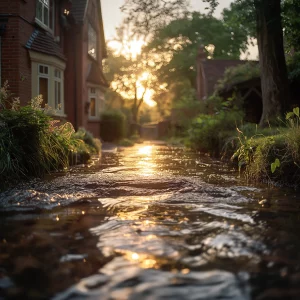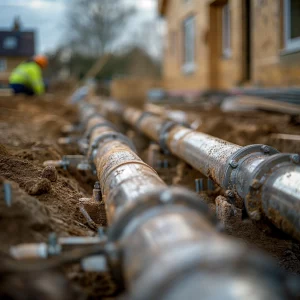In addressing the pervasive challenge of drainage issues within residential areas, particularly in regions such as London, homeowners and property managers encounter a myriad of problems stemming from a range of environmental and infrastructural factors. These issues compromise the structural integrity and aesthetic appeal of properties and pose significant health risks to occupants.
This comprehensive guide delves into the various aspects of house drainage concerns, offering insights into identifying problems, understanding their causes, and exploring practical solutions.
Ubiquitous Drainage Challenges
Drainage problems are a common headache for homeowners, arising from excessive rainfall, poor property slope, flat terrain, and surface or subsurface water flow direction. These factors can significantly hinder the effectiveness of a property’s drainage system, accumulating water in undesired locations. Such challenges are particularly pronounced in areas with high rainfall or flat topography, where water fails to drain away naturally.
Symptoms of Drainage Issues
The initial step in tackling drainage problems involves recognising the signs. Common indicators include the presence of pools of water, persistent wetness, mud, and areas of marshiness on lawn surfaces, all of which point towards water retention and accumulation issues. These symptoms are unsightly and signal potential damage to the property’s foundation and landscape, necessitating timely intervention.
Causal Factors and Impact
Several factors contribute to drainage issues, including incorrect placement of downspouts, soil compromise due to construction activities, and water trapping at property entrances. These problems can lead to structural damage over time, as water infiltration weakens foundations and erodes building materials. Additionally, stagnant water poses health risks by becoming a breeding ground for mosquitoes and other pests and promoting mould and mildew growth.
Drainage Function and System Operation
The efficacy of a home’s drainage system is foundational to maintaining a healthy and safe living environment. At its core, the system leverages gravity to guide wastewater from the property to municipal sewers or septic systems.
This setup is divided into two critical subsystems: the intake of fresh water, which supplies the home with potable water, and the expulsion of wastewater, which safely removes sewage and greywater from the premises. This system includes fixture drains and P-traps, which prevent sewer gases from entering the home, and a complex network of pipes that seamlessly transport water away, ensuring the dwelling remains dry and hygienic.
Preventative and Maintenance Measures
Prevention and maintenance are pivotal in avoiding the onset of drainage problems. Homeowners should regularly monitor soil conditions and waterlogging, clean gutters, inspect slopes and conduct vigilant inspections to detect issues early. Regular maintenance prevents minor problems from escalating into major issues, saving time, effort, and financial resources in the long run.
“Preventive maintenance is the cornerstone of a healthy drainage system. Regular inspections, timely cleaning, and mindful usage can significantly reduce the risk of severe drainage issues. It’s not just about fixing problems as they arise; it’s about preventing them from happening in the first place. A little effort in prevention can save homeowners a great deal of time, money, and stress, ensuring their property’s drainage system functions optimally for years to come.” – Mark Cordner, 24/7 Drainage UK.
Solution Spectrum and Diversity
Regarding solutions, a broad spectrum exists to cater to the varying needs of properties, depending on their topography, soil type, and local climate conditions. Solutions range from simple fixes like downspout extensions to more complex interventions such as the installation of rain gardens, grading, French drains, dry wells, and sump pumps. Each solution is tailored to address specific aspects of drainage challenges, emphasising the importance of a customised approach.
Sustainability and Ecological Balance
In pursuing sustainable and ecologically friendly drainage solutions, integrating rain gardens, permeable pavements, and Sustainable Urban Drainage Systems (SuDS) plays a critical role. These methods not only manage runoff in an environmentally responsible manner but also improve water quality and facilitate groundwater recharge. By adopting such practices, homeowners can contribute to the ecological balance while effectively managing water on their properties.
Regulatory Compliance and Information Sources
Navigating the regulatory landscape is a critical aspect of implementing effective drainage solutions. Homeowners must ensure compliance with local building codes and environmental regulations, which often dictate the permissible methods for runoff management and waste disposal. Engaging with local planning authorities and environmental agencies can provide valuable guidance and ensure that any interventions are effective and legally compliant.
Understanding and adhering to the best drainage maintenance and repair practices is essential for all homeowners. This includes recognising the importance of professional advice for complex issues, the benefits of regular maintenance schedules, and the need for environmentally responsible disposal of waste materials. By following these guidelines, homeowners can significantly reduce the likelihood of drainage problems and contribute to their communities’ overall health and sustainability.
Disposal and Cleaning
Drainage maintenance’s disposal and cleaning aspect underscores the importance of responsible practices. Homeowners should be mindful of properly disposing of fats, oils, and non-dissolvable materials while also employing safe cleaning methods and routine hot water flushes to maintain clear drains.
Guarding and Unblocking
Guarding against and unblocking clogged drainage systems involves a proactive approach. Installing drain guards, utilising DIY techniques such as plungers and drain snakes, and seeking professional assistance are all effective strategies for maintaining a functional drainage system.
Sharing Knowledge and Experiences
The power of shared knowledge cannot be understated in drainage management. We can share our experiences, challenges, and solutions through community forums, workshops, and online platforms. This collective wisdom empowers individual homeowners and strengthens our community’s resilience against common issues such as flooding, waterlogging, and pollution.
The Importance of Professional Partnerships
In our quest for effective drainage solutions, the value of professional advice and services is immeasurable. Engaging with drainage experts, landscapers, and environmental consultants gives us the insights and expertise to tackle complex challenges. These partnerships enhance the quality of our interventions and ensure that our actions are grounded in best practices and cutting-edge knowledge.
Looking Forward: The Future of Urban Drainage
As we look towards the future, the evolution of urban drainage systems and solutions holds promise for more resilient and sustainable communities. Technology, materials, and design innovations are continuously expanding our capabilities to manage water in urban environments. By staying informed, embracing change, and actively participating in developing and implementing new solutions, we contribute to a future where urban drainage systems are compelling and harmonious with the natural environment.





